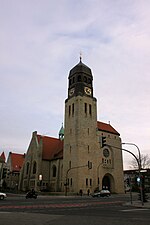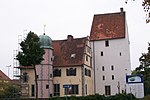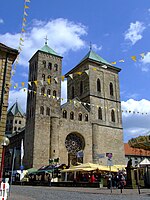Ems-Leine-Express
Named DB Regio servicesPages with no gauge entered in Infobox rail lineRail services in North Rhine-Westphalia
The Ems-Leine-Express (RE 60) is the name of a German Regional-Express service in North Rhine-Westphalia that has connected the Emsland city of Rheine, Lower Saxony, the regional centre of Osnabrück, the east Westphalian city of Minden and the Lower Saxony regional centres of Hanover and Braunschweig since 5 November 2000.The Ems-Leine-Express is notable for crossing the state border between Lower Saxony and North Rhine-Westphalia (NRW) three times at the following locations: between Ibbenbüren-Laggenbeck and Osnabrück Altstadt between Melle and Bünde between Minden and Bückeburg.
Excerpt from the Wikipedia article Ems-Leine-Express (License: CC BY-SA 3.0, Authors).Ems-Leine-Express
Theodor-Heuss-Platz, Osnabrück Innenstadt
Geographical coordinates (GPS) Address Nearby Places Show on map
Geographical coordinates (GPS)
| Latitude | Longitude |
|---|---|
| N 52.273 ° | E 8.0614 ° |
Address
Osnabrück Hauptbahnhof
Theodor-Heuss-Platz
49074 Osnabrück, Innenstadt
Lower Saxony, Germany
Open on Google Maps










